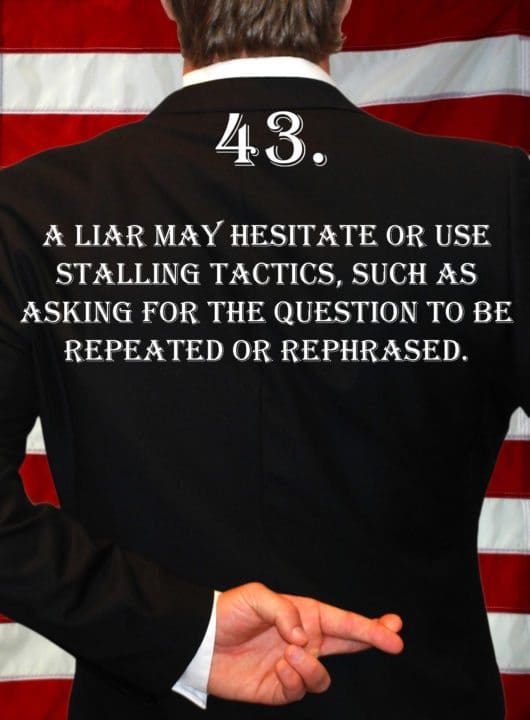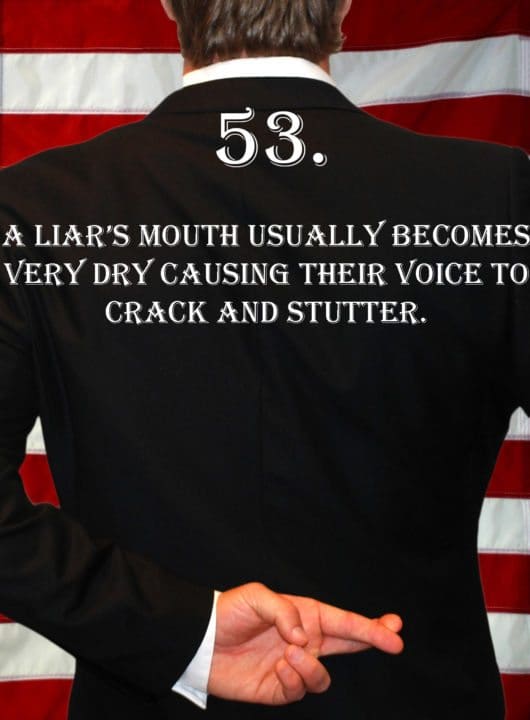
Deception Tip 43:
A liar may hesitate or use stalling tactics, such as asking for the question to be repeated or rephrased.
Listen To The Podcast!
E43 – Repeat The Question – Deception Tips Podcast – Click Here To Subscribe
Podcast Transcript
Hello and welcome to the deception tips podcast where you will learn amazing cues to detect deceit that will help you read people like never before, I’m your host Spencer Coffman, let’s get started.
Hello and welcome to episode 43 of the deception tips podcast. Last time we spoke of a cool sign about touching the neck or back of the neck, when people start to lie, or when they’re telling something that is untrue. It could be something as simple as a little white lie that they think isn’t a big deal but remember the unconscious doesn’t care.
Whether it’s a white lie or a red lie, a high stake lie, or a low stake, whether it’s simple or huge, meaningless, catastrophic, whatever the case may be, the unconscious mind doesn’t differentiate.
It says it’s either true or it’s not true, it’s either the truth or it’s a lie and if it’s a lie, then more and more body language leakage is going to appear because the unconscious wants the truth to go out.
It’s the conscious that justifies these things, that says, “No, it’s just a white lie” or “No, no one’s really going to get hurt by that lie” or “It’s a lie of no significance”, it’s still a lie, it doesn’t matter. So, the truth will come out via the unconscious, via signs of body language leakage that you can pick up on and use to discover the truth.
So, we talked about the back of the neck, when liars say these words, oftentimes, they’ll reach their hand and put it on the back of their neck. You see this all the time, sometimes in movies and in other situations usually, it’s around like politics or political meetings, like city council meeting, stuff like that where people are all together in those rooms.
They’re asking questions, they’re talking to someone, there’s a panel and they’re up in the front of the room behind their little podiums or desks or whatever. Everybody else is in the stands or in the seating area and one person or two people are talking, like a courtroom situation that type of a visual. You’ll always see someone putting their hand to the back of the neck when answering a question.
This is done to sort of massage away that tension and stress, remember we talked about that a lot, stress and tension. Anytime someone is telling a lie that stress level and that tension level are absolutely through the roof. There is no avoiding it unless you are a sociological or a pathological liar, which means you lie all the time and you’re very good at it, it’s comfortable for you.
In that case, they are an outlier, there is an exception to the rule which means that you’re probably not going to witness a lot of signs of deception when they lie because it’s so natural for them. However, other people, are going to demonstrate these signs because they have a lot of stress and tension, and uncertainty.
They do not want to get caught, they want people to believe the lie, a lie is unnatural, and all of these signs of leakage are coming out. So, they are able to be seen if you know what you’re looking for, so they can massage away that stress and tension in the back of the neck. Remember we also mentioned a couple of times ago when we talk about a tense neck that was back in episode 38.
So, it’s more than a couple of times ago, but it’s when the veins of the neck may protrude, and their neck is tense. Remember they’re massaging way that tension by putting the hand to the back of the neck, which also goes with the tense neck. Because if their veins are protruding then obviously it’s tense, so watch for that hand movement back there. So that is that, a little recap for you of last week and touch on episode 38.
So, if you haven’t heard those before then I really encourage you to listen to them anywhere you can. Wherever you’re listening to this just find those previous episodes, check them out.
Also, check out all the other episodes if you haven’t heard them because they are all providing you with some great information on detecting deception and reading people.
So, today we have a new deception tip, one that is more of a speech pattern or a way of people talking and conversing with others. We’ve touched on a few of these before, they are very popular when people talk and it’s something to watch out for when people are speaking. It’s a good one because you can just hear, all you need to do is listen for it.
We’ve touched on them like when we talked about people speaking in the third person, that was episode 33. We also talked about them when we had people who pledge their truthfulness using anti-life statements back in episode 24, distancing language in episode 18, those are all some popular ones when people are talking.
We have converting statements which is a huge one in episode 9 and then also episode 5 contractions, that’s one of the most easily recognizable. This one is going to be a rephrasing technique that liars are going to use to give themselves a little bit more time to think about and answer the question.
So, here it is, deception tip number 43, a liar may hesitate or use stalling tactics such as asking for the question to be repeated or rephrased. Here it is again, deception tip 43, a liar may hesitate or use stalling tactics such as asking for the question to be repeated or rephrased.
So, what does this mean? Well, it’s very simple, basically, you see it when people are trying to answer something that is a little bit uncomfortable for them. Usually, it results in a direct question or explaining yourself, such as when someone might be needing an excuse when they have either done something or when they’ve been accused of doing something.
Usually though, if they have merely been accused of doing it, they’re going to respond immediately. They’re going to be upset, they’re going to respond, they’re going to defend themselves right away. So, that is a little side note or a little bonus tip that you can use when detecting deception if you think or suspect a couple of different people may have stolen your money or something.
You accuse them both separately, of course, and whoever responds the quickest and defends himself faster keep an eye on them. This isn’t always true, but it might be true most of the time, obviously, you’re going to need to look for other patterns and clusters of behavior.
When people generally respond right away and defend themselves, most of the time it is because they are innocent and they want to convince you, they want to profess that.
However, a liar is probably going to be a little bit more dynamic and a little bit more fluid in terms of they are going to have like a strategy or they’re going to have like a plan of attack to convince you they didn’t steal your money. They’re going to have an alibi lined up, they’re going to be convincing, and they’re going to be a little bit more methodical.
That’s only if they’ve prepared that lie and anticipated that they are going to be accused. If it’s on the spot or spontaneous then they may not know what to say which then maybe they will use this, rephrase the question or repeat the question. So, we’re going to talk a lot more about this coming up right after this.
Have you ever gone to purchase a vehicle or appliance and weren’t really sure if the salesman was telling the truth? Now there’s a book that will help you spot the telltale signs of lying, it’s Spencer Coffman’s “A Guide to Deception.” Grab your copy today at spencercoffman.com or any major retailer.
Once again, we are on deception tip 43 where we are talking about different ways that liars may stall, it is a stalling tactic and it’s repeating or rephrasing the question. So, if you haven’t listened to the other podcasts that led up to this one, I encourage you to go back and listen to them.
Also, with this episode, I encourage you to share with other people, listen to it again and again so that you really remember the information, and talk about it with other people.
If you discuss it with other people, then you will be able to learn it a lot faster. Also, take note of when you use it in your own life and then ask yourself whether or what you said after that was a truth or a lie.
Remember if it’s even a little bit untrue, it counts as a lie according to the unconscious. We’re only talking about absolute truths with the unconscious, it’s things that are for sure true, it’s not the little white lies, all of that is considered a lie.
So, if you used one of these statements or something in your own life, then chances are what you may be saying next or what you said after that could be somewhat untrue. Yes, it may not hurt anybody, but it still might be untrue. “Hey, how you are doing today?” “Good.” “How do you like my haircut?” “What was that?” “How do you like my haircut?” “Oh, it’s okay.”
Maybe you really didn’t like their haircut, but you didn’t want to tell them that obviously because you’d hurt their feelings and be like a really big jerk. So, obviously, in society and in polite society, there are things that we do. “Did you like your gift from your grandmother?” “No, I absolutely hate it.” Well, you’re not going to say that, why? Because that’s terribly rude.
You’re going to say, “Yeah, I did, thank you Grandma” and then later you probably like, “You know, I really don’t like this gift, can we take it back?” Then after a couple of months, Grandma forgets about it or she won’t be worried about it anyway unless you have the type of Grandma that looks around for the gifts every time she comes over.
Anyway, liars use these tactics, these stalling, hesitating tactics, repeating or rephrasing the question. So, this can be done in two different ways, we’re going to talk about the second way later on. The first one is what we’re talking about right now, I will touch on the second one today, but otherwise, keep listening because it will come up in the future as its own tip.
So, when you ask the liar a question such as, “Did you steal my money?” They might say, “I’m sorry, I didn’t hear you, could you repeat that?” That’s a way that could say if it was a little bit more complicated question, did you steal my money is pretty straightforward. If it was something a little bit more technical or complex then they might say, “Could you rephrase that,” or “Would you ask it in a different way?”
Those are a little bit more unique, usually, people aren’t going to ask that, they’ll just say something like, “Could you repeat that please” or “I didn’t hear you”, “What was that?” Something to get you to say the question again. Why do they do this? It is because they need a little bit more time to mentally prepare for their lie. Now, you’re saying well a little bit more time, it only takes me a second to ask the question.
It doesn’t matter, it’s a little bit more time for them to take that stress level from about a thousand percent down to nine hundred percent. By hearing the question once, their conscious mind is already spinning at a million miles an hour, that hamster wheel is moving super-fast. Then they say can you repeat that boom, now you repeat it.
From the time they heard the question initially to the time that you finish saying it and then they pause for a couple of seconds to respond, that’s going to be a period of like 5 to 10 seconds. This means they have that much extra time to plan and think and decompressed and rehearse their lie one more time so they can tell it to you and be a little bit more confident that you will believe it.
Now rephrasing is a similar type of a deal, that one is going to take even more time because they would say, “Could you ask it in a different way?” That means you’re going to have to think up a different way, ask them then they can say something like, “Oh, I understand, I know what you mean.”
This is a further stalling tactic then they can get to the question, which could be a 10 to 15-second time-lapse which would really give them some time to level out, to respond to you, and try to convince you of that lie.
Now, the other side of this is when they might repeat the question themselves, so if you say, “Did you steal my money?” They might say, “Did I take your money? No.” Then they would go on to their explanation. Obviously, this is a yes or no question, these types of questions that you’re going to more likely experience this with are going to be the open-ended type or the storyline type.
Such as, “Where were you on Thursday night at 2 p.m. in the afternoon on such and such date?” Then they might say, “Wait a minute, what was that again?” Then they’d said, “Okay. Well, where were you on Thursday night at 2:00 p.m. on such and such date?” “Oh okay. Let’s see, on Thursday, let’s see, at noon I was probably, okay, so at two I was probably around here.”
So, look at all that time that it took from the initial moment of asking the question to now, they had a little bit more time to prepare and respond to that question. Now that was a combination tactic, they got the target to repeat the question then they repeated it themselves. So, now the liar had double-time to respond and come up with that lie.
Obviously, most of the time they’ve already thought of the lie but on a spontaneous question or something out of the blue, this tactic could be used a lot more because then they actually need a little bit more time to think of the lie that they are going to tell, so as always, watch for this.
Now, you may see this with a couple of other behaviors, shocker, right? There are always going to be clusters and patterns of behavior that you need to watch for. So, this one obviously since it is speech, there could be any type of gesture or any type of body language movement that goes with it. This means that you need to watch out for those things like symmetrically.
Touching the neck could even happen during this when they’re coming up with their answer like when they’re trying to think, they could do all kinds of things such as any of their lip movements or mirroring movements, which you could use to help out with this. Certain things like stepping backward, locking the ankles, watching out for their eye contact, stuff like that.
All of those little things that we’ve talked about before that are behavioral because usually, they’re not going to use multiple verbal signs at once. They may stack them up such as asking for the question to be repeated and then saying it again themselves, which are two signs. Plus, you can watch out for any other signs of body language such as physical movements that go along with that.
As always, you can stack the deck, so you could set them up for those movements such as having them prepare coffee while asking them this question. Remember we talked about that way back in episode 4, physical tasks. So, you can use all of these and try to get them to do as many as possible to see whether or not they really are telling the truth.
Once again, I want to thank you for listening to the deception tips podcast. Remember to share it with your friends, subscribe to the feed, check out the deception tips blog, also the deception tips videos, take a look at my books, and as always, tune in next week for a new deception tip.
Video Transcript
Hey guys, my name is Spencer Coffman, thank you for watching the deception tips videos. They’re all about teaching you how to read people and detect deception so that you’ll be able to tell if someone is lying to you. Today, we have a cool tip about communicating with other people and how people respond to certain questions.
It’s something we’ve talked about before a little bit when we talked about ‘yes’ and ‘no’ answers. Also, when we talked about quick answers way back when and it’s a stalling tactic or a delaying tactic when answering a question. So, here it is, deception tip number 43. A liar may hesitate or use stalling tactics such as asking for the question to be repeated or rephrased.
Now, these stalling tactics are something that is very hard to determine because usually, it’s a part of everyday conversation. So, if you ask me a question and I say, “Well, can you repeat the question please” or “Can I hear it again” or “What do you mean by XYZ?” So, oftentimes, if you ask me a hard question and I need some more time to think of it maybe I would do something like, what do you mean by this and get you to rephrase it without directly asking you to rephrase it.
So, these types of things are stalling tactics and they’re not something that’s normal. Most people when they’re asked a question and when they’re asking questions, they expect answers right away, they expect an answer now. I asked you the question, you should be able to answer because I asked you a question about something that you know about.
Where were you last night between 10:00 and 2:00? Well, let’s see, 10:00 and 2:00 p.m. I was probably sleeping, you know that. Whereas, if you need more time to think about it, then that could be suspicious and stalling tactics usually in normal conversation they don’t need to happen.
It’s like when we talked about yes-or-no questions and I asked you a yes-or-no question and you all of a sudden give me this big long answer. Hey, wait a minute, a yes-or-no question means yes or no, it’s really simple, yes or no. I don’t need the whole explanation, I don’t need all the stuff, it’s not an essay question, it’s a yes or no question.
So, when people use stalling tactics such as, well, can you repeat the question or can you use it in different words, can you rephrase that question? Okay, what do you mean by this word or this word? Those are all stalling tactics that really don’t need to be used unless you’re talking to someone who isn’t natively speaking whatever language you’re talking to them in.
So, if I was talking to someone whose native language is not English and they say can you repeat the question or can you rephrase it or what does this word mean, that’s a legitimate reason, they probably don’t understand what we’re saying. But, if you’re talking to someone who’s native in English, they should really know what you’re asking and if they don’t know what you’re asking then they could potentially be stalling.
So, in that case, pay attention to those other verbal things we’ve talked about such as quick answers of ‘yes’ and ‘no’, such as things like ‘yes’ or ‘no’ questions when they don’t answer ‘yes’ or ‘no’ or things where they really are starting on a huge essay question or these stalling tactics or those truthful behaviors such as, to be honest, or to tell the truth.
If you see any of those added things in language, contractions, splitting them apart, all that stuff, that’s all patterns and clusters. So, if you ask a question and then you hear that stalling tactic of rephrasing the question then pretty soon you notice they’re not using contractions, they are answering yes or no questions funnily, things like that, that’s a pattern and a cluster of behaviors.
Of course, there are going to be other body language signs with that but pay attention to all of that together because there will be a ton of patterns and clusters and individual signs of leakage that are going to be flowing out when they’re telling a lie that you can pick up on and steer the conversation to hone in on where their lie is and why they are lying.
So, if this is your first time watching these videos, I would love to have you subscribe to the channel on YouTube, feel free to leave any comments or questions on there as well. Also, if you’d like some more information, we’ve got books, podcasts, blog posts, all available on spencercoffman.com that are dedicated to teaching you exactly what every body is really saying.
Until next time.






